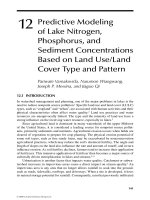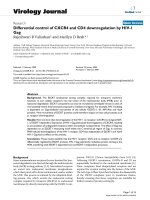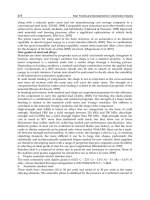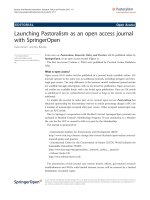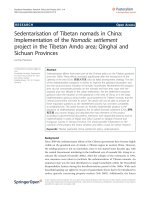Andreeßen and Steinbüchel AMB Express 2011, 1:12 docx
Bạn đang xem bản rút gọn của tài liệu. Xem và tải ngay bản đầy đủ của tài liệu tại đây (1.23 MB, 6 trang )
MINI - R E VIEW Open Access
Serinol: small molecule - big impact
Björn Andreeßen
*
and Alexander Steinbüchel
Abstract
The amino alcohol serinol (2-amino-1,3-propanediol) has become a common intermediate for several chemical
processes. Since the 1940s serinol was used as precursor for synthesis of synthetic antibiotics (chloramphenicol). In
the last years, new scopes of applications were discovered. Serinol is used for X-ray contrast agents,
pharmaceuticals or for chemical sphingosine/ceramide synthesis. It can either be obtained by chemical processes
based on 2-nitro-1,3-propanediol, dihydroxyacetone and ammonia, dihydroxyacetone oxime or 5-amino-1,3-
dioxane, or biotechnological application of amino alcohol dehydrogenases (AMDH) or transaminases. This review
provides a survey of synthesis, properties and applications for serinol.
Keywords: 2-Amino-1, 3-propanediol, Amino alcohol, Serinol
Introduction
2-Amino-1,3-propanediol (1,3-dihydroxy-isopropyla-
mine, aminoglycerin or amino-trimethylenglykol) has a
molecular formula of C
3
H
9
NO
2
(Figure 1), belongs to
the group of amino alcohols and is prochiral. As it is a
structural analogue to the amino acid serine, the com-
mon designation is serinol. It is very stable, corrosive,
hygroscopic, and dissolves v ery well in water. It has a
molecular weight of 91.11 g/mol, melts at 52 to 56 °C,
and has a boiling point of 115 to 116 °C. The term “seri-
nol” also describes the group of C-substituted commer-
cial analogs. As it is the case for most amino acids,
serinol and its derivatives are often used intermediates
in several chemical applications. In many organisms
mostly eukaryotic serinol derivatives function as central
second messengers. In a few prokaryotes serinol occurs
as an intermediate of toxin synthesis. In this paper, we
review the biological and chemical synthesis and appli-
cations for serinol and of some of its derivatives.
Natural occurrence of serino l
Serinol occurs in sugarcane (Saccharum officinarum),
where it can mediate the biosynthesis of the toxin
helminthosporoside (2-hydroxycyclopropyl-a-D-galacto-
pyranoside) by the pathogenic fungus Helminthosporium
sacchari (Babczinski et a l., 1978). Enzyme activity for
serinol synthesis was measured w ith crude leaf protein
extracts, pyridoxal-5-phosphate, dihydroxyacetone
phosphate (D, HAP), and alanine. A K
m
value of 0.1 to
1 mM for serinol was determined for this enzyme. They
also discovered tha t glutamine, glutamic, as well as
aspartic acid served as amino donors for the transami-
nase with similar efficiencies. However, the responsible
gene and protein for the transamination reaction,
respectively, have not been unraveled so far.
Serinol also constitutes an intermediate in rhizobitox-
ine, i. e. 2-amino-4-(2-amino-3-hydropropoxy)-trans-
but-3-enoic acid, biosynthesis by the plant pathogen
Burkholderia andropogonis (Mitchell et al 1986) and the
legume symbionts Bradyrhizobium japonicum and its
close relative Bradyrhizobium elkanii (Owen et al.
1972). Rhizobitoxine is a well known inhibitor of ethy-
lene biosynthesis. Due to this inhibition, an i ncreased
rhizobitoxine production enhances nodulation and com-
petitiveness on Macroptilium atropurpureum, the purple
bush-bean, or siratro (Yuhashi et al., 2000). Rhizobitox-
ine synthesis was most thoroughly investigated in B. elk-
anii.Tn5 insertion in the rtxA gene of B. elkanii caused
a rhizobitoxine null mutant. The N-terminal region of
RtxA has a motif homologous to several aminotrans-
ferases (Ruan and Pet ers 1992,, Ruan et al. 1993) as the
346 N-terminal amino acids of RtxA exhibit 24% iden-
tity and 40% similarity to the aminotransferase of
Methanobacterium thermoautotrophicum (Smith et al.,
1997,). Mutants with a disruption of the N-terminal part
of the protein were defective in serinol accumulation
(Yasuta et al 2001,). The N-terminal domain of RtxA
catalyzes the reaction from DHAP to serinol phosphate
* Correspondence:
Institut für Molekulare Mikrobiologie und Biotechnologie, Westfälische
Wilhelms-Universität Münster, Corrensstraße 3, D-48149 Münster, Germany
Andreeßen and Steinbüchel AMB Express 2011, 1:12
/>© 2011 Andreeßen and Steinbüchel; licensee Springer. This is an Open Access article distributed under the terms of the Creative
Commons Attribution License ( which permits unrestricted use, distribution, and
reproduction in any medium, provided the ori ginal work is properly cited.
and further dephosphorylation to serinol (Yasuta et al.
2001,). Glutamic acid, followed by alanine and aspartic
acid are the preferred amino donors for this transamina-
tion reaction (Andreeßen and Steinbüchel, 2011). Inser -
tions in the C-terminal part of t he protein lead to a
decrease of dihydrorhizobitoxine in B. elkanii USD94.
The 443 C-terminal residues exhibit 41% identity and
56% similarity to the O-acetylhomoserine sulfhydrolase
of Leptospira meyer (Bourhy et al., 1997,). Therefore,
Yasuta et al. (2001) concluded, that RtxA, exhibiting a
molecular mass of 90 kDa, is a bifunctional enzyme
comprising a dihydroxyacetone phosphate aminotrans-
ferase activity and a dihydrorhizobitoxine synthase activ-
ity at the same time. Dihydrorhizobitoxine is further
conve rted to rhizobitoxine by the rhizobitoxine desatur-
ase RtxC (Okazi et al. 2004). Introduction of the rt xAC-
DEFG operon into Agrobacterium tumefaciens C58
resulted in serinol formation but no rhizobitoxine was
synthesized (Sugawara et al. 2007).
Natural occurrence of serino l-derivatives
Besides the already described compound serinol
(2-amino-1,3-propanediol), several chiral derivatives
exist. Of particular importance are the acylated serinols
(sphingosines). Sphingosine (F igure 2F) and its N-acy-
lated derivative, cerami de (Figure 2G), are central
second messengers in eukaryotes. They are involved i n
regulation of cell growth, endocytosis, stress response,
and apoptosis (Furuya et al. 1998,, Bieberich et al. 2000,,
Hannun and Luberto, 2000,, Uchida et al., 2003). Several
serinol derivatives were obtained from marine sponges
(Molinsky 2004). From Stelletta inconspicua, for exam-
ple, the N-acylated serinol inconspicamide (N-palmitoyl-
2-amino-1,3-propanediol, Figure 2H) has been extracted
(Ueka et al. 2008). Spingosine and ceramide synthesis are
best described in yeasts, e. g. Saccharomyces cerevisi ae.
Based on serine and palmitoyl-coenzyme A (CoA)
3-ketodihydrospingosine is condensated by a serine
palmitoyltransferase and further reduced to dihydro-
sphingosine by a 3-ketosphinganine reductase. Ceramide
is synthesized by the addition of a second palmitoyl
moiety from palmitoyl-CoA, catalyzed by a ceramide
synthase. Further modifications can occur by e. g. hydro-
xylases (Di ckson and Lester, 2002). Among yeasts Pichia
ciferri (formerly Hansenula ciferri) is of major industrial
interest. They secrete tetra-acetyl-phytosphingosine
(TAPS, Figure 2E) as the crystalline form to the medium,
whereof it is easily purified (Wickerham and Stodola
1960,, Casey et al. 1995,, 1997, 13de Boer and van der
Wildt 2001).
Applications for serinol
In general, aminoalcohols exhibit a multitude of applica-
tions in medicine and chemical industry. Long chain
a,ω-aminoalcohols serve as fungizides (Nicholas et al.,
2002,). Moreover, amino acid derived amino alcohols
constitute important intermediates for enantiomerically
pure substances (Cossy et al., 2009). Based on N-
acetyl-1,3-amino alcohols, sphingosines for dermatolo-
gical or generally pharmaceutical purposes can be
synthesized (Singh et al., 2004,). Since the 1940s, seri-
nol and its commercial C-substituted analogs were a
popular motif in organic compounds (10,Darabantu
2010a and b). Synthetic N-acylated serinols (N-palmi-
toyl-2-amino-1,3-propanediol) are discu ssed to function
as anti-cancer drugs as they increase ceramide-induced
(Figure 2G) apoptosis ( Bieberich et al. 2000, Ueoka et al.
2008). Furthermore, the synthetic sphingosine (Figure
2F) and, since 2010 the first oral drug in multiple sclero-
sis treatment, fingolimod (2-amino-2-[2-(4-octylphenyl)
ethyl]propane-1,3-diol, Figure 2D) distributed as Gile-
nya
®
(Novartis) are synthesized from serinol (Burana-
chokpaisan et al., 2006). Moreover, chiral (1R,2R)
phenylserinol (Figure 2B) is a common intermediate in
industrial chloramphenicol (Figure 2C) production
(Darabantu et al., 1995,), and aromatic L-serinol-deriva-
tives are important intermediates for epinephrine and
norepinephrine synthesis (Nakazawa et al., 1975).
Serinol is also used as an intermediate for non-
ionic X-ray contrast agents like iopamidol (1-N,3-N-
Figure 1 Structural formula of serinol (2-amino-1,3-p ropanediol) (A) and serinol as term for the group of C-su bstituted commercial
analogs (B).
Andreeßen and Steinbüchel AMB Express 2011, 1:12
/>Page 2 of 6
bis(1,3-dihydroxypropan-2-yl)-5-[(2S)-2-hydroxypropa-
namido]-2,4,6-triiodobenzene-1,3-di-carboxamide,
Figure 2A), which is for example distributed as iopa-
miro
®
,isovue
®
(both Bracco Diagnostic s Inc.) or scan-
lux
®
(Sanochemia). Iopamidol is employed as a contrast
agent for angiography throughout the cardiovascular
system (Villa and Paiocchi, 2003).
Furthermore, serinol constitutes a precursor for drugs
dealing with pain treatment. Therefore, a straight or
branched alkyl chain consisting of 12 to 22 carbon
atoms is linked to the C2 atom of serinol (Michaelis et
al. 2009).
Chemical synthesis of serinol
Until now serinol is normally produced by chemical
synthesis (Figure 3). Most of the amino alcohols or their
precursors are of petro-chemical origin or need
hazardousreagentsduringsynthesis (Piloty and Ruff,
1897,, Pfeiffer 1980,, Thewalt et al. 1984,, Felder et al.
1985,, Felder et al. 1987,, Fedoronko et al. 1989,, Quirk
et al.1989,, Nardi et al. 1999,, Kodali 2008). Common
fossil fuel derived precursors are 2-nitro-1,3-propan ediol
(Pfeiffer 1980,, Thewalt et al. 1984,, 16, Felder et al.
1985), nitromethane (Schmidt and Wilkendorf 1919,),
dihydroxyacetone (DHA) (Felder et al. 1981), dihydrox-
yacetone oxime (Piloty and Ruff, 1897,, Fedoronko et al.
1989,, Nardi et al. 1999,) or 5-amino-1 ,3-dioxane (Quirk
et al.1989).
The first synthesis of serinol was reported by Piloty
and Ruff (1897). They reduced dihydroxyacetone oxime
with sodium amalgam in presence of aluminum
sulphate. For purification serinol was converted into the
corresponding hydrochloride with yields up to 15%
(wt/wt) relative to the oxime starting material.
Figure 2 Serinol moiety containing compounds. A: iopami dol, B: phenylserinol C: chloramphenicol. D: fingolimod. E: tetra-acetyl -
phytosphingosine F: dihydrosphingosine. G: ceramide. H: inconspicamide. The serinol units are marked in red.
Andreeßen and Steinbüchel AMB Express 2011, 1:12
/>Page 3 of 6
Schmidt and Wilkendorf (1919) synthesized several
derivatives of 1,3-propanediol. First, p-formaldehyde and
nitromethane condensate in presence of aqueous
sodium hydroxide, then the accrued sodium salt of 2-
nitro-1,3-propanediol, oxalic acid, and palladinated bar-
iumsulfate react to serinol oxalate with yiel ds up to 93%
(wt/wt) of the theoretical value. The sodium salt of 2-
nitro-1,3-propanediol was also used as raw ma terial for
serinol production by Pfeiffer (1980). Na
+
-nitropropane-
diol dihydrate, ammonium chloride, and raney nickel as
a catalyst were solved in methanol and incubated at
room temperature and 70 bar pressure. After several
distillation and purification steps 75.5% (wt/wt) serinol
with a purity of 99.6% were obtained. Application of pal-
ladium on carbon catalyst (5% Pd/C, 50% water) instead
of raney nickel gave 74.6 to 94.5% (wt/wt) serinol recov-
ery with about 98.7% purit y (Thewalt et al. 1984,). How-
ever, nitromethane as well as 2-nitro-1,3-propanediol
are highly explosive. Consequently, Felder et al. (1985),
used epichlorohydrin in presence of alkali with metha-
nol or ethanol to form 1,3-dia lkoxyis opropanol, which
was further converted to 1,3-dialkoxy-isopropyl halide.
Addition of ammonia or a primary or secondary amine
formed a 1,3-dialkoxy-isopropylamine. In the last step
the ether groups were separated by hydrochloric acid,
yielding 80 to 91% (wt/wt) serinol with a purity of
99.8%. Furthermore, they used DHA, ammonia, and
raney-nickel as a catalyst, dissolved in methanol (100
bar, 70 °C) for hydration (Felder et al. 1987). For purifi-
cation, raw serinol was converted into the corresponding
oxalate (yield: 87.2% wt/wt).
Quirk et al (1989) used tris(hydroxymethyl)nitro-
methane derived from the reaction of nitromethane and
3 moles of formaldehyde instead of DHA or 2-nitro-1,3-
propanediol. Tris(hydroxymethyl)nitromethane and a
ketone formed catalyzed by a strong acid (HCl or
Figure 3 Chemical (red arrows) and biological (green arrows) synthesis of serinol. Catalysts are highlighted in red, enzymes are marked in
green. R
1
and R
2
correspond to alkoxy groups, R3 and R4 represent C1-C10 alkyl, C3-C10 cycloalkyl or aryl group, or form together a C4-C10
alkylene group. AMDH: amino alcohol dehydrogenase, RtxA: dihydroxyacetone phosphate aminotransferase/dihydrorhizobitoxin synthase. Until
now only the transaminase RtxA of B. elkanii is described. Another one is assumed for sugarcane.
Andreeßen and Steinbüchel AMB Express 2011, 1:12
/>Page 4 of 6
H
2
SO
4
) 5-hydroxymethyl-5-nitro-1,3-dioxane derivative.
This derivative was converted into the corresponding
5-nitro-1,3-dioxane when treated with alkali. The nitro
group was hydrogenated to an amino group employing
rhodium, platinum or palladium catalysts. Serinol was
isolated from the accrued 5-amino-1,3-dioxane in pre-
sence of a st rong organic acid (Yield: 70 to 93% wt/wt).
Nardi et al. (1999) used dihydroxyacet one oxime with
rhodium on aluminium as catalys t, incubated it for 16 h
at 70 °C and 70 bar and obtained 90% (wt/wt) of crude
serinol.
However, all these manufacturing processes exhibited
partial disadvantages like unsatisfactory yields, formation
of dangerous by-products or poorly accessible or fossil
fuel derived raw materials ( Thewalt et al. 1980,, Felder
et al. 1987,). The expense of some reactants and the
required equipment led to processes unsatisfactory for
industrial applications (Quirk et al. 1989,). In addition,
1-amino-2,3-propandiol, which can be hardly separated
from serinol, is generated during s ome chemical synth-
eses (Felder et al. 1987).
Biotechnological synthesis of serinol
Research on biosynthesis processes depending on a bio-
logical approach was only marginal (Figure 3). Nakazawa
et al. (1975) applied different aldehydes to grow ing
cultures of Brevibacterium helvolum, Candida humicola
and Coryneacterium glycinophilum. The highest
amounts of serinol derivatives were achieved with C.
humicola and the substrates p-nitrobenzaldehyde or
3,4-dinitrobenzaldehyde (8 g/l). The formation of serinol
derivatives by B. helvolum or C. glycinophilum was
slightly lowe r (B. helvolum and p-dimethylaminobenzal-
dehyde: 1.4 g/l, C. glycinophilum and p-nitrobenzalde-
hyde: 2.5 g/l).
Biotechnological production of the serinol derivatives
sphingosine, dihydrosphingosine or phytosphingosine
has already been established with several mutants of
Pichia ciferri. These st rains produce up to 0.8 g/l TAPS
when grown under batch culture conditions (Ca sey et
al. 1995,, 1997,, de Boer and van der Wildt, 2001).
Serinol can be biochemically synthesized by amino
alcohol dehydrogenases (AMDH). Itoh et al. (2000) iso-
lated a strictly NAD
+
/NADH-dependent AMDH from
Streptomyces virginiae IFO 12827. The AMDH catalyzed
the reversible dehydrogenation of serinol in presence of
NAD
+
with a K
m
value of 4.0 mM to provide DHA,
ammonium and NADH. The K
m
for the back-reaction,
the reductive amination of DHA, decreased to 2.2 mM
for DHA.
Our laboratory showed an a rtificial pathway for seri-
nolproductioninrecombinantEscherichia coli.For
this, the bifunctional dihydroxyacetone phosphate
aminotransferase/dihydrorhizobitox in synthase RtxA
or only its N-terminal dom ain (RtxA513), comprising
the first reaction as described above, was heterolo-
gously expressed in E. coli.Upto3.3g/lserinolwere
accumulated in t he supernatant by the rec ombinant
strains, possessing whether RtxA or RtxA513, growing
in presence of glycerol as sole carbon source. As no
higher yields were achieved, intracellular serinol con-
tent was considered to be toxic for the cells. To lower
the probable toxic effect, conversion into the corre-
sponding acylester was intended. B ut an in vitro deri-
vatization employing wax ester synthase/acyl-CoA:
diacylglycerol acyltransferase (WS/DGAT) from A.
baylyi ADP1 was not possible (Andreeßen and Stein-
büchel, 2011).
Conclusions
As described in this r eview, several applications for
serinol or its derivatives are possible. Until now, large
scale production of serinol is carried out via chemically
processes (Piloty and Ruff, 1897,, Pfeiffer 1980,, Thewalt
et al. 1984,, Felder et al. 1985,, Felder et al. 1987,, Fedor-
onko et al. 1989,, Quirk et al.1989,, Nardi et al. 1999,
Kodali 2008). But most of these processes are based on
fossil fuel derived precursors. In times of declining oil
reserves, new methods for serinol synthesis or its deriva-
tives are needed. The knowledge about m icrobial alter-
natives, summarized by this review, offers a good
starting point for further research. The fermentative
production of sphingosin es by Pichia ciferri (Casey et al.
1995,, 1997,, 13,de Boer and van der Wildt, 2001) and
seri nol production from glycerol (Andreeßen and Stein-
büchel, 2011) are promising examples for processes
based on renewable resources.
Acknowledgements
Financial support from the BMVEL/FNR (FKZ 22015806, 06NR158) is gratefully
acknowledged. We also acknowledge support by Deutsche
Forschungsgemeinschaft and Open Access Publication Fund of University of
Muenster.
Competing interests
The authors declare that they have no competing interests.
Received: 16 April 2011 Accepted: 13 June 2011
Published: 13 June 2011
References
Andreeßen B, Steinbüchel A (2011) Biotechnological conversion of glycerol to
2-amino-1,3-propanediol (serinol) in recombinant Escherichia coli. DOI:
10.1007/s00253-011-3364-6
Babczinski P, Matern U, Strobel GA (1978) Serinol phosphate as an intermediate
in serinol formation in sugarcane. Plant Physiol 61:46–49
Bieberich E, Kawaguchi T, Yu RK (2000) N-acylated serinol is a novel ceramide
mimic inducing apoptosis in neuroblastoma cells. J Biol Chem 275:177–181
Bourhy P, Martel A, Margarita D, Saint GI, Belfaiza J (1997) Homoserine
O-acetyltransferase, involved in the Leptospira meyeri methionine biosynthetic
pathway, is not retroinhibited. J Bacteriol 179:4396–4398
Buranachokpaisan T, Dannenfelser RM, Li P (2006) Compound formulations of 2-
amino-1,3-propanediol compounds. WO 2006010630 (A1)
Andreeßen and Steinbüchel AMB Express 2011, 1:12
/>Page 5 of 6
Cameron DC, Altaras NE, Hoffman ML, Shaw AJ (1998) Metabolic engineering of
propanediol pathways. Biotechnol Prog 14:116–125
Casey J, Maume KA, Peters ALJ, Veloo RM (1995) Preparation of
phytosphingosine derivative. EP688871-A, EP688871-A1, EP688871-A2,
JP8168392-A, US5618706-A
Casey J, Maume KA, Peters ALJ, Veloo RM (1997) Preparation of
phytosphingosine derivative. US5618706-A
Cossy J, Pardo DG, Dumas C, Mirguet O, Dechamps I, Metro TX, Burger B,
Roudeau R, Appenzeller J, Cochi A (2009) Rearrangement of β-amino
alcohols and application to the synthesis of biologically active compounds.
Chirality 21:850–856
Darabantu M (2010a) (Masked) serinol: molecules, biomolecules, building-block,
supramolecules. Part (I): syntheses based on serinols’ reactivity with carbonyl
electrophiles. Curr Org Synth 7:120–152
Darabantu M (2010b) (Masked) serinol: molecules, biomolecules, building-block,
supramolecules. Part (II): serinolic approaches in current organic synthesis.
Curr Org Synth 7:235–275
Darabantu M, Mager S, Plé G, Puscas C (1995) Heterocyclic saturated compounds
as derivatives or precursors of chloromycetine and some related structures.
Heterocycles 41:2327–2356
de Boer L, van der Wildt IFC (2001) Microbial strains producing sphingolipid
bases. US patent 6204006
Dickson RC, Lester RL (2002) Sphingolipid functions in Saccharomyces cerevisiae.
Biochim Biophys Acta 1583:13–25
Fedoronko M, Petrusova M, Alfoldi J (1989) Electroreduction of triose oximes.
Chem Pap - Chem Zvesti 43:335–341
Felder E, Bianchi S, Bollinger H (1985) Process for the preparation of serinol and of
serinol derivatives, and products obtained therefrom. US patent 4503252 (A)
Felder E, Römer M, Bardonner H, Härtner H, Fruhstorfer W (1987) Verfahren zur
Herstellung von Hydroxyaminen. European patent 0238961 (A2)
Furuya S, Mitoma J, Makino A, Hirabayashi Y (1998) Ceramide and its
interconvertible metabolite sphingosine function as indispensable lipid
factors involved in survival and dendritic differentiation of cerebellar Purkinje
cells. J Neurochem 71:366–377
Hannun YA, Luberto C (2000) Ceramide in the eukaryotic stress response. Trends
Cell Biol 10:73–80
Itoh N, Yachi C, Kudome T (2000) Determining a novel NAD(+)-dependent amine
dehydrogenase with a broad substrate range from Streptomyces virginiae IFO
12827: purification and characterization. J Mol Catal B: Enzym 10:281–290
Michaelis M, Geisslinger G, Scholich K (2009) 2-Amino-1,3-propanediol
compounds for the treatment of acute pain. US patent 2004248988 (A1)
Mitchell RE, Frey EJ, Benn MK (1986) Rhizobitoxine and L-threo-hydroxythreonine
production by the plant pathogen Pseudomonas andropogonis.
Phytochemistry 25:2711–2715
Molinski RF (2004) Antifungal compounds from marine organisms. Curr Med
Chem - Anti-Infective Agents 3:197–220
Nardi A, Villa M (1999) Process for the preparation of 2-amino-1,3-propanediol.
US patent 5922917 (A)
Nakazawa H, Enei H, Kubota K, Okumura S (1975) Biological method of
producing serine and serinol derivatives. US patent 3871958 (A)
Nicholas GM, Li RH, MacMillan JB, Molinski TF (2002) Antifungal activity of
bifunctional sphingolipids. Intramolecular synergism within long-chain alpha,
omega-bis-aminoalcohols. Bioorg Med Chem Lett 12:2159–2162
Noble MEM, Zeelen JP, Wierenga RK, Mainfroid V, Goraj K, Gohimont AC,
Martial JA (1993) Structure of triosephosphate isomerase from Escherichia coli
determined at 2.6 Å resolution. Acta Crystallogr Sect D: Biol 49:403–417
Okazaki S, Sugawara M, Minamisawa K (2004) Bradyrhizobium elkanii rtxC gene is
required for expression of symbiotic phenotypes in the final step of
rhizobitoxin biosynthesis. Appl Environ Biotechnol 70:535–541
Owen LD, Thompson JF, Pitcher RG, Williams T (1972) Structure of rhizobitoxine,
an antimetabolic enol-ether amino-acid from Rhixobium japonicum. J Chem
Sci Chem Commun 1972:714
Pfeiffer H (1980) Process for the preparation of serinol (1,3-dihydroxy-2-
aminopropane). US patent 4221740 (A)
Piloty O, Ruff O (1897) Ueber einige Aminoalkohole der Fettreihe. Ber Dtsch
Chem Ges 30:2057–2068
Quirk JM, Harsy SG, Hakansson CL (1989) Novel process for the preparation of
serinol. European patent 0348223 (A2)
Ruan X, Peters NK (1992) Isolation and characterization of rhizobitoxine mutants
of Bradyrhizobium japonicum. J Bacteriol 174:3467–3473
Ruan X, Zhang C, Peters NK (1993) Bradyrhizobium japonicum rhizobitoxine genes
and putative enzyme functions: expression requires a translational frameshift.
Proc Natl Acad Sci USA 90:2641–2645
Singh OV, Kampf DJ, Han HS (2004) Oxazine formation by MsCl/Et3N as a
convenient tool for the stereochemical interconversion of the hydroxyl
group in N-acetyl 1,3-aminoalcohols. Asymmetric synthesis of N-acetyl
L-xylo- and L-arabino-phytosphingosines Tetrahedron Lett 45:7239–7242
Schmidt E, Wilkendorf R (1919) Über einige Derivate des Trimethylenglykols. Ber
Dtsch Chem Ges 52:389–399
Smith DR, Doucette-Stamm LA, Deloughery C, Lee HM, Dubois J, Aldredge T,
Bashirzadeh R, Blakely D, Cook R, Gilbert K, Harrison D, Hoang L, Keagle P,
Lumm W, Pothier B, Qiu D, Spadafora R, Vicare R, Wang Y, Wierzbowski J,
Gibson R, Jiwani N, Caruso A, Bush D, Safer H, Patwell D, Prabhakar S,
McDougall S, Shimer G, Goyal A, Pietrovski S, Church GM, Daniels CJ, Mao JI,
Rice P, Nolling J, Reeve JN (1997) Complete genome sequence of
Methanobacterium thermoautotrophicum ΔH: functional analysis and
comparative genomics. J Bacteriol 179:7135–7155
Sugawara M, Haramaki R, Nonaka S, Ezura H, Okazaki S, Eda S, Mitsui H,
Minamisawa K (2007) Rhizobitoxine production in Agrobacterium tumefaciens
C58 by Bradyrhizobium elkanii rtxACDEFG genes. FEMS Microbiol Lett
269:2–35
Thewalt K, Bison G, Egger H (1984) Process for the preparation of 2-
aminopropanediol-1,3 (serinol). US patent 4448999 (A)
Uchida Y, Nardo AD, Collins V, Elias PM, Holleran WM (2003) De novo ceramide
synthesis participates in the ultraviolet B irradiation-induced apoptosis in
undifferentiated cultured human keratinocytes. J Invest Dermatol
120:662–669
Villa M, Paiocchi M (2003) Process for the purifying of iopamidol. US patent
6506938 (B1)
Wickerham LJ, Stodola FH (1960) Formation of extracellular sphingolipides by
microorganisms I. Tetraacetylphytosphingosine from Hansenula ciferri.J
Bacteriol 80:484–491
Yasuta T, Okazaki S, Mitsui H, Yuhashi KI, Ezura H, Minamisawa K (2001) DNA
Sequence and mutational analysis of rhizobitoxine biosynthesis genes in
Bradyrhizobium elkanii. Appl Environ Microbiol 67:4999–5009
Yuhaschi KI, Ichikawa N, Ezura H, Akao S, Miniakawa Y, Nukui N, Yasuta T,
Minamisawa K (2000) Rhizobitoxine production by Bradyrhizobium elkanii
enhances nodulation and competitveness on Macroptilium atropurpureum.
Appl Environ Microbiol 66:2658–2663
doi:10.1186/2191-0855-1-12
Cite this article as: Andreeßen and Steinbüchel: Serinol: small molecule -
big impact. AMB Express 2011 1:12.
Submit your manuscript to a
journal and benefi t from:
7 Convenient online submission
7 Rigorous peer review
7 Immediate publication on acceptance
7 Open access: articles freely available online
7 High visibility within the fi eld
7 Retaining the copyright to your article
Submit your next manuscript at 7 springeropen.com
Andreeßen and Steinbüchel AMB Express 2011, 1:12
/>Page 6 of 6
